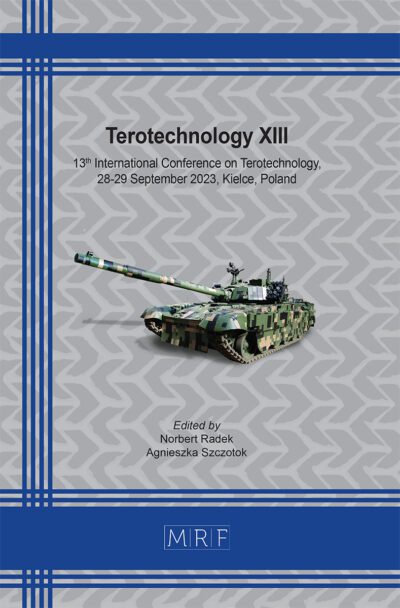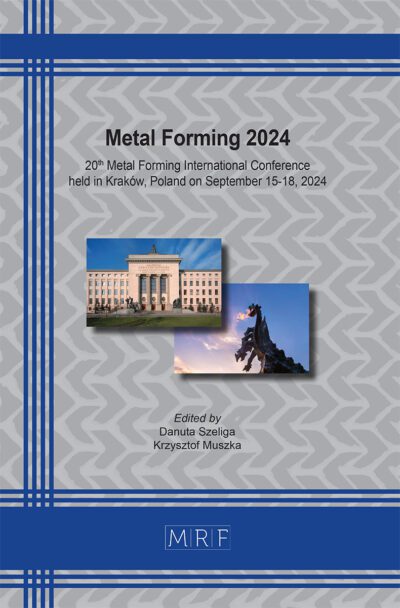Effect of material characterization via torsion tests on the accuracy of FEM simulations in the extrusion process
Sara Di Donato, Riccardo Pelaccia, Marco Negozio, Nicola Lai, Mohamad El Mehtedi, Barbara Reggiani, Lorenzo Donati
Abstract. The Finite Elment Method codes are nowadays potent and useful tools for advancing the design and optimization of metal forming processes. This is particularly evident in sectors such as aluminum extrusion, where FEM contributes to both process enhancement and tool development, mitigating the high costs and time demands of experimental trials. However, accurate and reliable simulations require precise material flow stress modeling. In this context, the hot torsion test is considered the most suitable for material characterization as it allows for achieving the high strain levels typical of the extrusion process while maintaining stable temperature and strain rate conditions during testing. This work presents the characterization via torsion tests of four distinct alloys, all classified within the AA6082 series, obtained from different casting batches. The resulting data were subsequently employed as input for numerical simulations of an industrial extrusion process and compared with experimental results to assess the impact of flow stress modeling on the accuracy and reliability of the simulations.
Keywords
Hot Torsion Test, Flow Stress, Material Characterization, Aluminum Extrusion, FEM Simulation
Published online 5/7/2025, 12 pages
Copyright © 2025 by the author(s)
Published under license by Materials Research Forum LLC., Millersville PA, USA
Citation: Sara Di Donato, Riccardo Pelaccia, Marco Negozio, Nicola Lai, Mohamad El Mehtedi, Barbara Reggiani, Lorenzo Donati, Effect of material characterization via torsion tests on the accuracy of FEM simulations in the extrusion process, Materials Research Proceedings, Vol. 54, pp 780-791, 2025
DOI: https://doi.org/10.21741/9781644903599-84
The article was published as article 84 of the book Material Forming
![]() Content from this work may be used under the terms of the Creative Commons Attribution 3.0 license. Any further distribution of this work must maintain attribution to the author(s) and the title of the work, journal citation and DOI.
Content from this work may be used under the terms of the Creative Commons Attribution 3.0 license. Any further distribution of this work must maintain attribution to the author(s) and the title of the work, journal citation and DOI.
References
[1] L. Donati, B. Reggiani, R. Pelaccia, M. Negozio, S. Di Donato, Advancements in extrusion and drawing: a review of the contributes by the ESAFORM community, Int J Mater Form 15 (2022) 41. https://doi.org/10.1007/s12289-022-01664-w
[2] R. Pelaccia, M. Negozio, S. Di Donato, B. Reggiani, L. Donati, Numerical simulation of the extrusion process with different FEM code approaches: analysis of thermal field, profile speed, defects evolution, and microstructure of hollow tubes, in: 2024: pp. 771–780. https://doi.org/10.21741/9781644903131-85
[3] L. Raimondi, F. Bernardi, Advanced hybrid laminates: elastomer integration for optimized mechanical properties, Int J Adv Manuf Technol 136 (2025) 3177–3195. https://doi.org/10.1007/s00170-025-15023-x
[4] F. Bernardi, A. Sensini, L. Raimondi, L. Donati, On the infiltration of cellular solids by sheet molding compound: process simulation and experimental validation, Int J Adv Manuf Technol 133 (2024) 3745–3755. https://doi.org/10.1007/s00170-024-13977-y
[5] M. Negozio, A. Segatori, R. Pelaccia, B. Reggiani, S. Di Donato, L. Donati, Modeling of recrystallization behaviour of AA6xxx aluminum alloy during extrusion process, Transactions of Nonferrous Metals Society of China 34 (2024) 3170–3184. https://doi.org/10.1016/S1003-6326(24)66600-8
[6] M. Negozio, R. Pelaccia, L. Donati, B. Reggiani, S. Di Donato, Microstructure Evolution and FEM Prediction on AA6XXX Alloys, Key Engineering Materials 987 (2024) 3–10. https://doi.org/doi:10.4028/p-qO8WAd
[7] K. Zhang, K. Marthinsen, B. Holmedal, T. Aukrust, A. Segatori, Through thickness variations of deformation texture in round profile extrusions of 6063-type aluminium alloy: Experiments, FEM and crystal plasticity modelling, Materials Science and Engineering: A 722 (2018) 20–29. https://doi.org/10.1016/j.msea.2018.02.081
[8] S. Di Donato, R. Pelaccia, M. Negozio, Phase Field Method for the Assessment of the New-Old Billet Material Interaction during Continuous Extrusion Using COMSOL Multiphysics, J. of Materi Eng and Perform (2024). https://doi.org/10.1007/s11665-024-10013-8
[9] R. Pelaccia, M. Negozio, S.D. Donato, L. Donati, B. Reggiani, Recent Trends in Nitrogen Cooling Modelling of Extrusion Dies, Key Engineering Materials 987 (2024) 11–22. https://doi.org/doi:10.4028/p-Q0NDkB
[10] M. Negozio, R. Pelaccia, L. Donati, B. Reggiani, S. Di Donato, Validation of charge welds and skin contamination FEM predictions in the extrusion of a AA6082 aluminum alloy, in: 2023: pp. 86–93. https://doi.org/10.21741/9781644902714-11
[11] J.D. Bressan, R.K. Unfer, Construction and validation tests of a torsion test machine, Journal of Materials Processing Technology 179 (2006) 23–29. https://doi.org/10.1016/j.jmatprotec.2006.03.099
[12] M. El Mehtedi, S. Spigarelli, F. Gabrielli, L. Donati, Comparison Study of Constitutive Models in Predicting the Hot Deformation Behavior of AA6060 and AA6063 Aluminium Alloys, Materials Today: Proceedings 2 (2015) 4732–4739. https://doi.org/10.1016/j.matpr.2015.10.006
[13] S. Di Donato, R. Pelaccia, M. Negozio, M.E. Mehtedi, B. Reggiani, L. Donati, Hot Torsion Tests of AA6082 Alloy, Key Engineering Materials 988 (2024) 21–29. https://doi.org/10.4028/p-5c0LIi
[14] S.C. Shrivastava, J.J. Jonas, G. Canova, Equivalent strain in large deformation torsion testing : Theoretical and practical considerations, Journal of the Mechanics and Physics of Solids 30 (1982) 75–90. https://doi.org/10.1016/0022-5096(82)90014-X
[15] G.E. Dieter, H.A. Kuhn, S.L. Semiatin, eds., Handbook of workability and process design, ASM International, Materials Park, Ohio, 2003.
[16] R. Pelaccia, M. Negozio, S. Di Donato, B. Reggiani, L. Donati, Extrusion Benchmark 2023: Effect of Die Design on Profile Speed, Seam Weld Quality and Microstructure of Hollow Tubes, Key Engineering Materials 988 (2024) 47–62. https://doi.org/10.4028/p-gNXRC5
[17] Jr. Fields, W.A. Backofen, Determination of strain-hardening characteristics by torsion testing, Proc. Am. Soc. Test. Mater. 57 (1957) 1259–1272.
[18] B. Verlinden, A. Suhadi, L. Delaey, A generalized constitutive equation for an AA6060 aluminium alloy, Scripta Metallurgica et Materialia 28 (1993) 1441–1446. https://doi.org/10.1016/0956-716X(93)90496-F













